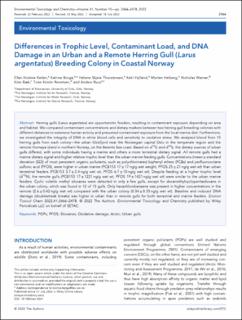Differences in Trophic Level, Contaminant Load, and DNA Damage in an Urban and a Remote Herring Gull (Larus argentatus) Breeding Colony in Coastal Norway
Keilen, Ellen Kristine; Borgå, Katrine; Thorstensen, Helene Skjeie; Hylland, Ketil; Helberg, Morten; Warner, Nicholas Alexander; Bæk, Kine; Reiertsen, Tone Kristin; Ruus, Anders
Peer reviewed, Journal article
Published version
Permanent lenke
https://hdl.handle.net/11250/3028055Utgivelsesdato
2022Metadata
Vis full innførselSamlinger
- Publikasjoner fra Cristin - NIVA [2149]
- Scientific publications [1172]
Sammendrag
Herring gulls (Larus argentatus) are opportunistic feeders, resulting in contaminant exposure depending on area and habitat. We compared contaminant concentrations and dietary markers between two herring gull breeding colonies with different distances to extensive human activity and presumed contaminant exposure from the local marine diet. Furthermore, we investigated the integrity of DNA in white blood cells and sensitivity to oxidative stress. We analyzed blood from 15 herring gulls from each colony—the urban Oslofjord near the Norwegian capital Oslo in the temperate region and the remote Hornøya island in northern Norway, on the Barents Sea coast. Based on d13C and d34S, the dietary sources of urban gulls differed, with some individuals having a marine and others a more terrestrial dietary signal. All remote gulls had a marine dietary signal and higher relative trophic level than the urban marine feeding gulls. Concentrations (mean ± standard deviation [SD]) of most persistent organic pollutants, such as polychlorinated biphenyl ethers (PCBs) and perfluorooctane sulfonic acid (PFOS), were higher in urban marine (PCB153 17 ± 17 ng/g wet weight, PFOS 25 ± 21 ng/g wet wt) than urban terrestrial feeders (PCB153 3.7 ± 2.4 ng/g wet wt, PFOS 6.7 ± 10 ng/g wet wt). Despite feeding at a higher trophic level (d15N), the remote gulls (PCB153 17 ± 1221 ng/g wet wt, PFOS 19 ± 1421 ng/g wet wt) were similar to the urban marine feeders. Cyclic volatile methyl siloxanes were detected in only a few gulls, except for decamethylcyclopentasiloxane in the urban colony, which was found in 12 of 13 gulls. Only hexachlorobenzene was present in higher concentrations in the remote (2.6 ± 0.42 ng/g wet wt) compared with the urban colony (0.34 ± 0.33 ng/g wet wt). Baseline and induced DNA damage (doublestreak breaks) was higher in urban than in remote gulls for both terrestrial and marine feeders.

